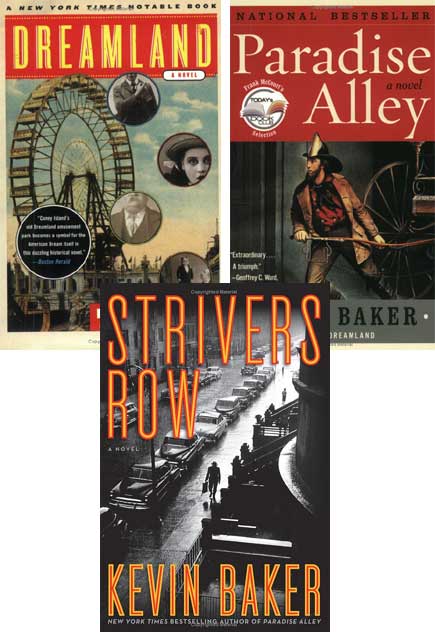| book recommendations

City Of Fire triology
by Kevin Baker
These are just way too good. Historical fiction that takes place in New York City at three different periods. Dreamland takes place in 1910. From Amazon:
|
Kevin Baker's Dreamland is the kind of novel that begins with a two-page list of characters and ends with a nine-page glossary. In between, this vast, sprawling carnival of a book takes in Coney Island and the Lower East Side, midgets and gangsters, Bowery bars and opium dens, even Sigmund Freud and Carl Jung. It is, in short, a novel as big, lively, and ambitious as Gotham itself, and if you can stomach some of the more garish local color, it's every bit as much fun. Set at the turn of the century, in a New York as polyglot as any city on earth, Dreamland opens with an act of misplaced--and very stupid--compassion. Eastern European immigrant Kid Twist intervenes when villainous gangster Gyp the Blood is on the verge of murdering a young newsboy for sport. But surprise: that's no street urchin--that's Trick the Dwarf, self-proclaimed Mayor of Little City and a Coney Island tout, who dresses up as a boy, he says, as "a way I had of leaving myself behind." Trick hides Kid Twist in the hind parts of the Tin Elephant Hotel; Kid Twist meets Esther Abramowitz, impoverished seamstress and labor agitator, then falls in love; Trick woos Mad Carlotta, a three-foot beauty who thinks she's the Empress of Mexico; and Freud and Jung sail for America, where they squabble about psychoanalysis. There are also a few subplots involving police corruption, Tammany Hall, and the Triangle Shirtwaist Fire--but who's counting?
| |
Paradise Alley takes place during the Civil War draft riots. From Amazon:
|
Paradise Alley, Kevin Baker's follow-up to Dreamland, makes full use of his skills as a top historical researcher. Paradise Alley concerns a tumultuous moment in the record of the Civil War: the 1863 New York riots that followed President Lincoln's decision to create a draft. Baker refers to the street violence as one of the worst instances of civic unrest in American history. Yet one can't tell a compelling story with simple pronouncements. Baker gives us a handful of characters--fictional, yet emblematic--who lead readers through the dense weave of class, race, ambition, gender politics, and violence in mid-19th-century America. More importantly, Baker has that rare gift of establishing crucial links between the past and the present, of helping a reader understand that we live with the consequences of history. A hugely ambitious project, Baker wrestles with his responsibility to the overall vision as well as to many, many outstanding moments, and for the most part he gets the balance right.
| |
And Strivers Row takes place in WWII Harlem. From Amazon:
|
Played out against the backdrop of Harlem in 1943, this generally engaging, sometimes dense third novel from Baker (following the bestselling Dreamland and Paradise Alley) reimagines the early days of Malcolm Little—the man who became Malcolm X. As depicted by Baker, the young Malcolm is quick-witted, eager, reckless and impulsive, but also sensitive and possessing a strong sense of justice. These qualities lead to a chance encounter in which he helps Jonah Dove (the Dove family is familiar from Paradise Alley), a young Harlem minister who is struggling with his own demons as the fair-skinned leader of a black church that has not truly embraced him, despite his being the only son of the church's much-beloved founder; Dove's unfolding story (including his struggles with passing) deepens Malcolm's. The book stays within what's already known about Malcolm X's early adulthood, but Baker covers the territory carefully. He also thoroughly captures the figures (Adam Clayton Powell Jr., West Indian Archie, the Collyer brothers, etc.) and micropolitical climate of wartime Harlem: munitions factories have brought jobs to the struggling community, but low wages, rationing, racial hostilities and an increasing military and police presence makes for possibly explosive combinations. When these tensions do reach the breaking point, Baker lends the resulting fray a visceral reality.
| |
These were books I couldn't put down. Great use of period language and weaving actual historical people and incidents to tell a great story.
|

